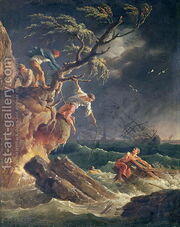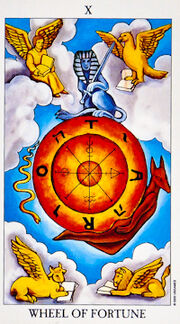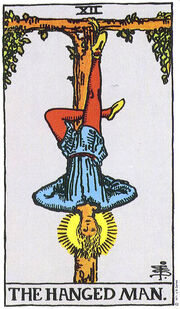
The Tempest
Phoenician Sailor[]
The Phoenician Sailor – Phlebas, the Smyrna Merchant – Mr. Eugenides, have the same symbolic character, and are related to Shakespeaere’s play The Tempest. In The Tempest, Ariel’s song to the shipwrecked Ferdinand, is about the drowning of Ferdinand’s father, Alonso. The Waste Land has many references about The Tempest: the drowning of Alonso and Ferdinand is seen as their purification by water, so Eliot was impressed by the perspective or the view that the suffering is changed into art. Ferdinand is related to Phlebas, and Mr. Eugenides. Since drowning is done by water, which this leads to purification, water plays diverse roles in the poem and is the symbol of purification, baptism, refreshment, and growth.
.............
Belladonna - Lady of the Rocks[]

Leonardo da Vinci's "Madonna of the Rocks"
“Belladonna” means beautiful lady. The word suggests Madonna (the Virgin Mary) and, therefore, the Madonna of the Rocks as in Leonardo da Vinci’s painting. The rocks symbolize the church. But there are also other rocks – rocks of dryness of the waste land. Belladonna is also an eye-cosmetic and a poison – the deadly nightshade. In the next line, the figure of the Virgin becomes “the lady of the situations” – the woman in the waste land –
Man with Three Staves[]
The “man with three staves” is the life-force symbol associated with the Fisher King. The Fisher King is in the Arthurian legend. He represents water and when wounded by his own spear, shows the representation as water being drained out, there’s no more water, therefore turns into the wasteland. He was restored later by the knight Percival through the Holy Grail.
Wheel[]
The “wheel” is the Wheel of Fortune, whose turning represents the reversals of human life.

Wheel of Fortune
One-eyed Merchant[]
Mr. Eugenides is the “one-eyed merchant” because the figure is in profile on the card. “One-eyed” also carries a suggestion of crookedness. The mysterious burden on his back may be the mysteries of the fertility cult (a particular system of religious worship, especially with reference to its rites and ceremonies).
The Hanged Man[]
“The Hanged Man” represents the hanged god of Frazer (including the Christ), is associated with the “hooded figure” in the passage of the disciples to Emmaus in “What the Thunder Said”. In the Tarot cards, the hanged man is shown hanging from one foot from a T-shaped cross. He symbolizes the self-sacrifice of the fertility god who is killed in order for his resurrection may bring fertility again to the land and people. He is “hooded” accounts for Madame Sosostris inability to see him.

The Hanged Man